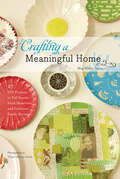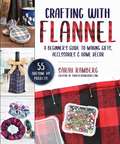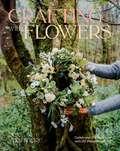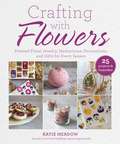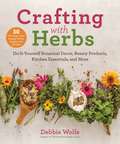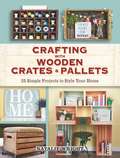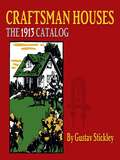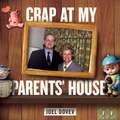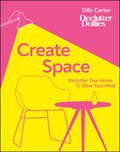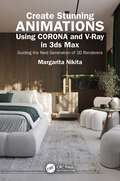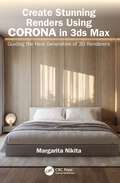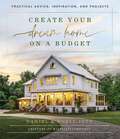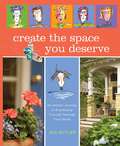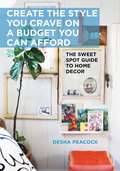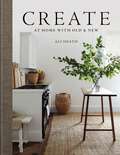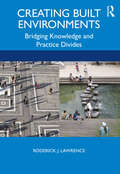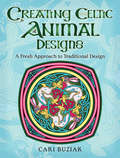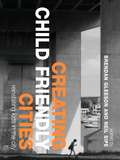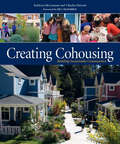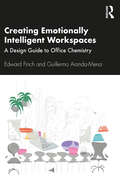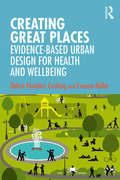- Table View
- List View
Craft the Rainbow: 40 Colorful Paper Projects from The House That Lars Built
by Brittany Watson JepsenThe popular craft designer and lifestyle blogger shares a rainbow of new project ideas—all using the creative power of paper.What began as a project collection and viral Instagram hashtag (#CrafttheRainbow) has become an inspiring book featuring all-new paper project ideas. Learn how to make playful party decorations, luscious flowers, amazing cards, and sophisticated wreaths, garlands, centerpieces, and more than you can imagine. Brittany Watson Jepsen is known for the unusually imaginative and amazingly beautiful designs she creates for her website and host of clients (including Anthropologie). In Craft the Rainbow, Jepsen walks readers through the easy basics of transforming simple paper—including tissue, crepe, cardstock, leaves of books, and vintage and recycled paper—into vibrant, fanciful, handmade projects suitable for every occasion.
Crafting a Meaningful Home: 27 DIY Projects to Tell Stories, Hold Memories, and Celebrate Family Heritage
by Meg Mateo IlascoTwenty-seven projects to personalize your living space: “This heartwarming craft book reminds me why I love decorating my own home so much.” —Lena Corwin, author of Printing by HandHome is our refuge and a part of our identity. These DIY projects let us craft a space that celebrates who we are and where we’ve been. In Crafting a Meaningful Home, Meg Mateo Ilasco shares twenty-seven projects that tell personal stories and celebrate heritage, all easily created on a budget. Learn how to decoupage a plate with photos of a best friend; silkscreen upholstery with folk motifs; artfully display love notes; sew a teepee from a vintage quilt top; create family silhouettes for a festive banner; and much more. Contributed by a cast of well-known designers from across the country, the projects are, at once, nostalgic, sentimental, and modern. Clear instructions are easy to follow, even for beginning crafters.
Crafting with Flannel: A Beginner's Guide to Making Gifts, Accessories & Home Décor
by Sarah RambergAdd a flannel flair to every corner of your life with this creative collection of DIY crafts: pillow covers, tote bags, fabric pumpkins, coasters, bookmarks, and more! Very few fabrics elicit such a cozy feeling as flannel. With its universal appeal and inexpensive cost, flannel is a terrific medium to create new décor for your home, a unique accessory to wear, or a thoughtful gift to give. Featuring more than fifty easy-to-follow tutorials, Crafting with Flannel is full of creative and inspired crafts appropriate for all ages and skill levels. From quick and easy projects that take just minutes to make, to more robust ideas on a larger scale, the step-by-step instructions inside this book will help you create: Handmade giftsPersonalized accessoriesCozy home décor Festive holiday trimmingsAnd so much more! Plaid never goes out of style, so channel the flannel and start crafting with it!
Crafting with Flowers: Celebrate the Seasons with 20 Floral Projects
by Bex PartridgeCrafting with Flowers is a stunning book centred around crafting with both fresh and dried flowers, encouraging the reader to connect with nature and create stylish projects for their homes, spaces and to gift to others. The book features 20 practical projects and activities to help readers pause their hectic lives and immerse themselves in a connection to nature and creativity. From simple and cute ideas like flower crowns and garlands, to gorgeous seasonal wreaths and kokedama, all the projects in Crafting with Flowers connect the reader to the outside world, providing them with a beautiful piece to enjoy in their home. Bex gives helpful guidance on the best plants to use for each project and provides tips and techniques to get the most from your creations.With stunning photography and inspiring projects, Crafting with Flowers will give you the confidence and inspiration to bring nature into the home and allow you to find moments of calm and joy.
Crafting with Flowers: Pressed Flower Decorations, Herbariums, and Gifts for Every Season
by Katie MeadowMake Your Own Unique, Whimsical Gifts and Treats Inspired by Nature's Beauty! Everyone could add a bit of brightness to their daily life. This book will teach you how to make a wide range of floral crafts, and help you truly connect to nature and the magical woodlands. The crafts are organized seasonally, so you can happily craft all year round and always have gifts at the ready. Beginning with lovely spring crafts using bright, beautiful flowers, summer crafts aimed more at weddings, celebrations, and festivals, such as dried flower button holes and pressed flower nail art. In autumn we move to more cozy self‑care crafts like bath salts and candles, and winter includes crafts that are handmade gift ideas such as pressed flower cards and ornaments. Crafts include: Crystallized edible flowers to top cakes and cupcakesBotanical wax sachets to keep your closet freshly scentedPink rose petal bath bombsBeautiful botanical framesFlower-infused cookies and chocolates
Crafting with Herbs: Do-It-Yourself Botanical Decor, Beauty Products, Kitchen Essentials, and More
by Debbie WolfeCapture the beauty, fragrance, and power of herbs in these delightful crafts for home and garden. Why craft with herbs? They're easy to grow, beautiful, fragrant, full of health benefits, and are incredibly versatile! Herbs are best known for their medicinal and culinary uses, but there&’s so much more you can do with them. From spray disinfectants to wreaths and garlands, custom herb salts to homemade skincare products, there's something here for every room of your house—and everyone on your gift list! Learn how to make beautiful and useful items such as:Smudge SticksHerb SachetsHanging Herbal SwagNatural ConfettiHerbal Cleaning VinegarsHerb salts (with recipes for different blends)Herbal Teas Compound Herb ButterLavender Neck WrapSimple Herbal BalmAnd much more!In addition to the crafts, learn how to grow, prune, harvest, dry, and store your favorite herbs. Woven throughout are helpful tidbits on the wellness properties and history of herbs.Create useful crafts that will beautify your home and make wonderful DIY gifts!
Crafting with Wooden Crates and Pallets: 25 Simple Projects to Style Your Home
by Natalie WrightYou don't have to be a carpenter or a home improvement expert to undertake these twenty-five projects, which combine elements of crafting and woodworking. Step-by-step instructions, accompanied by full-color photos, explain how to build surprisingly simple, attractive, and inexpensive indoor and outdoor furniture. The common denominators in these fun-filled and practical projects are ordinary wooden crates and pallets, which are readily available at craft and home improvement stores, vintage shops, and online. The first project demonstrates how easy it is to build your own crate from scratch. Indoor projects include storage shelves, nightstands, a bookshelf, an upholstered footstool, a benche, a side table, a desk, and storage units. Stepping outside, the projects feature a do-it-yourself children’s lemonade stand and a planter box. Several of the projects are equally functional indoors and out: decorative pieces, a game, a sign, a rolling cart, a toolbox, and other handy and playful items. The ease and simplicity of the projects make them a great way for novices — especially kids — to discover the pleasures and satisfaction of crafting and workworking.
Craftsman Houses: The 1913 Catalog
by Gustav StickleyGustav Stickley pioneered a form of architecture based on beauty, simplicity, utility, and organic harmony. This inexpensive reprint of a very rare catalog testifies to the enduring charm of his designs. It comprises numerous architectural drawings and photographs of Mission-style homes, including floor plans and descriptive text."Planned for comfort, convenience, and economy," each of these homes features a simple arrangement of rooms and sturdy structural features. Combining good taste with practicality, they offer openness for common household life, as well as sufficient seclusion for privacy. Models range from a two-family house of cement or stucco to a nine-room cottage of brick and shingles and a seven-room country bungalow. Restorers of old houses, preservationists, and students of American architectural history will prize this well-illustrated treasury of authentic plans and details.
Crap at My Parents' House
by Joel DovevAn illustrated celebration of the trinkets and tchotchkes that accumulate over a lifetime—and turn ordinary family homes into weird museums . . . Deer-hoof bottle openers. Grizzly bear toilet paper holders. A copy of Sports Illustrated from 1983 with Hulk Hogan on the cover. You never know what you might find lurking at your parents&’ house. Standup comic and blogger Joel Dovev has made it his personal quest to compile a catalog of the useless, tacky, and utterly bizarre items that moms and dads not only acquire in the first place, but refuse to throw out, all for reasons unbeknownst to their kids. If you&’ve ever helped with cleaning and organizing efforts—or just opened up a junk drawer or a box in the basement during a visit home—you&’re sure to recognize the feeling of stumbling across treasures such as these and asking yourself, &“Why?&” Packed with photos and humorous observations, Crap at My Parents&’ House is a very special journey sure to provoke a mixture of tender nostalgia . . . and head-shaking bafflement.
Create Space: Declutter your home to clear your mind
by Dilly CarterCut the clutter, live better with less, give yourself headspace, and enjoy life more. Create Space shows you how taking steps to clear and simplify your living space can also clear your mind, improve your relationships, and enhance your well-being. This room-by-room guide to organizing and decluttering your home is packed with ideas, advice, tips, and techniques that are practical and functional as well as beautiful. Turn chaos into calm with step-by-step methods that you can adapt and sustain for your own needs.When you stop allowing your life to revolve around things that don't matter, you instantly gain energy to focus on the things that do. Reclaim your space, your time, and your mind right now, to reorganize your living space into a place of sanctuary.
Create Stunning Animations Using Corona and V-Ray in 3ds Max: Guiding the Next Generation of 3D Renderers
by Margarita NikitaThis book is a step-by-step guide on how to create realistic animations using Corona and V-Ray within 3ds Max. It caters to beginners and intermediate users, helping them transform static renders into dynamic and captivating animations. It combines technical knowledge with practical examples, covering everything from basic principles to advanced techniques.By the end of this book, readers will: Understand the fundamentals of animation in 3ds Max Learn to animate cameras, objects, and lights effectively Create realistic animated scenes using Corona and V-Ray Explore time-saving workflows and rendering optimization tips Develop a polished animation portfolio ready for professional projects This book is structured as a nuts-and-bolts how-to guide, breaking down complex animation techniques into manageable steps. Each chapter focuses on a specific aspect of animation, blending foundational knowledge with advanced tips to enhance the reader’s understanding and capability. Through detailed explanations, visual examples, and step-by-step tutorials, this book aims to demystify the animation process for beginners while offering advanced insights for experienced users.
Create Stunning Renders Using Corona in 3ds Max: Guiding the Next Generation of 3D Renderers
by Margarita NikitaThis book is a comprehensive step‑by‑step guide tailored for designers seeking to elevate their visualization skills using the powerful combination of Corona 11 in 3ds Max 2024.It begins by acquainting readers with the 3ds Max interface and fundamental commands, ensuring a solid foundation for navigating the software. Readers will be guided through the process of assigning Corona and fine‑tuning rendering settings, setting up cameras, and mastering both natural and artificial lighting techniques within their scenes.It then progresses to the creation of materials, their application to the scene, and the utilization of Corona’s libraries and presets for efficiency. The potentials of Corona are detailed using a bedroom scene as an example. This practical guide demystifies the complexities of 3D rendering without delving into modeling techniques.With design studios increasingly incorporating 3D renderings into their proposals, Create Stunning Renders Using Corona in 3ds Max: Guiding the Next Generation of 3D Renderers serves as an invaluable resource for professionals and aspiring renderers alike. It aspires to contribute significantly to the evolution of the next generation of 3D rendering artists, making it an essential companion for those eager to master the art of photorealistic renderings in the dynamic landscape of 3ds Max and Corona 11.
Create Your Dream Home on a Budget: Practical Advice, Inspiration, and Projects
by Noell Jett Daniel JettHave you always wanted to transform your house into the home of your dreams but you're not sure where to begin? Create Your Dream Home on a Budget will equip you with the motivation and how-to you need to create living spaces you love on a budget you can afford. With inspiration from beautiful photos, DIY projects, and foundational building and renovation concepts, you'll be on your way to creating your own dream home.Seasoned home-renovation experts and TikTok stars Daniel and Noell Jett (@JettSetFarmhouse) know a thing or two about building gorgeous homes with cost-effective tips and tricks. You'll learn how to add functionality, beauty, and charm to each room of your home--including ideas for outdoor spaces--whether you're renovating or building from the ground up! In Create Your Dream Home on a Budget, the Jetts provide:Steps to modernize your home without a major renovationDIY expertise for laying tileTips to install your own closet system to stay organizedInstructions to add or replace new features such as lighting fixturesAnd so much more! Every week, Daniel and Noell Jett inspire millions of followers on their own home makeover journeys. You'll complete your unique do-it-yourself projects and create a foundation of beauty for your own living spaces in no time! Create Your Dream Home on a Budget makes the perfect self-purchase, housewarming present, birthday gift, Mother's Day read, or holiday gift.
Create the Space You Deserve: An Artistic Journey To Expressing Yourself Through Your Home
by Jill Butler"Settling for just any roof over my head was not a choice." —Jill ButlerSuccessful and talented artist, illustrator, designer, businesswoman, and author Jill Butler uses her bold and captivating artwork, along with stunning photography of her nothing-special-turned-dream-cottage, to inspire readers to do more with their living spaces and in turn more with their lives. Hundreds of decorating tips and ideas are accompanied by mind-maps and other illustrations reflecting the myriad of decisions, emotions, and questions readers will face. Part guide to creating the space you want to live in, part journal to help you reevaluate, reinvent, and revitalize yourself, Create the Space You Deserve is a launching pad to access your creative self and express your personality onto your living space.
Create the Style You Crave on a Budget You Can Afford: The Sweet Spot Guide to Home Decor
by Desha PeacockAn Inspiring, Eclectic, and Practical Guide to Creating Your Dream Living Space, on a BudgetIn this unique and hip home decor style guide, you will find the inspiration to explore your own sense of style, discover the essence of what makes your home feel good to you, and learn how to mix vintage, modern, and thrift store finds to create the eclectic look you crave on a budget you can afford.Create the Style You Crave on a Budget You Can Afford is different from most decorating books. While filled with eye candy, it also explores how creatively expressing yourself in your home and garden helps you create the life you really want to live. No matter your budget or style, you'll be inspired by stories of everyday women with busy lives and limited budgets who have infused personal values, meaning, and style into making their own "sweet spot" homes. Instead of feeling overwhelmed, you will feel inspired as you see how other women like you have done it, with style-developing tools such as mood boards. With the help of loads of resources, both online and off, you can create an environment that reflects who you are and what you want, so you can draw more of that into your life.
Create: At Home with Old & New
by Ali HeathSome of the most exciting interiors around are those that layer vintage and antique finds with select contemporary pieces. In Create, interior stylist and journalist Ali Heath encourages you to think imaginatively about how to bring together old and new at home - introducing individuality and interest, while incorporating the need to decorate more sustainably.Following on from the success of her first book Curate, Create is a visual feast divided into three engaging and informative chapters. Establishing Your Style will fire your imagination, while Adding the Magic considers various decorating elements, including pattern and texture, curiosities and collections, furniture and furnishings, art and display, and lighting. In Creative Spaces the homes of a maverick group of 10 antique dealers and interior designers are shared - offering a mix of pared-back neutral homes and more colourful spaces -,providing a fresh new take on artfully combining old and new. The book is full of insightful advice from experts and gives readers a valuable sourcebook to return to for inspiration. With glorious photography, original drawings and break-out ideas pages, Create will give you the confidence to nurture a home you love - one that celebrates the past while embracing the present and future.
Create: At Home with Old & New
by Ali HeathSome of the most exciting interiors around are those that layer vintage and antique finds with select contemporary pieces. In Create, interior stylist and journalist Ali Heath encourages you to think imaginatively about how to bring together old and new at home - introducing individuality and interest, while incorporating the need to decorate more sustainably.Following on from the success of her first book Curate, Create is a visual feast divided into three engaging and informative chapters. Establishing Your Style will fire your imagination, while Adding the Magic considers various decorating elements, including pattern and texture, curiosities and collections, furniture and furnishings, art and display, and lighting. In Creative Spaces the homes of a maverick group of 10 antique dealers and interior designers are shared - offering a mix of pared-back neutral homes and more colourful spaces -,providing a fresh new take on artfully combining old and new. The book is full of insightful advice from experts and gives readers a valuable sourcebook to return to for inspiration. With glorious photography, original drawings and break-out ideas pages, Create will give you the confidence to nurture a home you love - one that celebrates the past while embracing the present and future.
Creating A Beautiful Home
by Alexandra StoddardAlexandra Stoddard has brought beauty and grace to the lives of millions all over the world through her many books, including the phenomenal betseller, Living a Beautiful Life. In Creating a Beautiful Home, Alexandra Stoddard generously shares her professional secrets as an interior designer as well as her personal experiences in renovating and decorating her own 1775 home in Connecticut. Once again, her original and imaginative ideas for every room in the house will inform and inspire you on your own exciting journey of discovery as you transform your living space into a warm and welcoming oasis of harmony, beauty, and joy.
Creating Built Environments: Bridging Knowledge and Practice Divides
by Roderick J. LawrenceBuilt environments are complex, emergent, systemic, and require contextual analysis. They should be understood before reconsidering how professionals and researchers of the built environment are educated and trained to reduce the gap between knowledge, practice and real-world circumstances. There is an urgent need to rethink the role of policy makers, researchers, practitioners and laypeople in the construction, renovation and reuse of the built environment in order to deal with numerous environmental/ecological, economic/financial and social/ethical challenges of providing a habitat for current and future generations in a world of continual change. These challenges are too complex to be dealt with only by one discipline or profession. Combinations of different types of knowledge, knowing in praxis and tacit knowledge are needed. This book presents and illustrates recent innovative contributions with case studies focusing on five strategic domains and the interrelations between them. These transdisciplinary contributions apply concepts, methods and tools that facilitate convergence and concerted action between participants collaborating in policy definition and project implementation. The methods and tools include experiments in living-labs, prototypes on site and virtual simulations, as well as participatory approaches including citizen science, the development of alternative scenarios, and visioning plausible futures.
Creating Celtic Animal Designs: A Fresh Approach to Traditional Design
by Cari BuziakMany instruction books just teach how to duplicate designs without providing any clues for the next step — making your own! This unique guide features the highly effective Aon method, a technique for creating your own original designs rather than copying examples. It's easy to comprehend, with simple step-by-step instructions that focus on incorporating animal forms into Celtic patterns and designs.Creating Celtic Animal Designs builds on author Cari Buziak's experience teaching and writing about Celtic patterns and their creation, meaning, and history. Her nine in-depth examples encompass both traditional and contemporary renderings of animals — hounds, lions, hares, birds, and other creatures. Cari demonstrates the freehand drawing of Celtic knots and moves beyond the basics to show how to manipulate and develop stand-alone patterns into panels and combinations. Artists, designers, art instructors, tattoo artists, and anyone who appreciates Celtic designs will find this book a treasury of both instruction and inspiration.
Creating Child Friendly Cities: New Perspectives and Prospects
by Neil Sipe Brendan GleesonFirst Published in 2006. Routledge is an imprint of Taylor & Francis, an informa company.
Creating Cohousing
by Kathryn Mccamant Charles DurrettCohousing balances privacy and independence with the benefits of living in community. This completely revised and updated third edition of the "cohousing bible" invites readers into these sustainable neighborhoods, and provides practical tools for developing their own.
Creating Effective Spaces: Declutter, Organize and Maintain Your Space
by Natasha SwinglerAn effective space is one that works for you, liberating you to live the life you want. Natasha Swingler’s decluttering and organization solutions save time, space, and look amazing!Natasha takes you around the home and shares her hacks from the kitchen to the bedroom via the office and hallway. Never again will you need to step over your "floordrobe", rifle through the shoe rack, or spend ten minutes searching for keys.Applying Natasha’s "house rules" to every room, drawer, and cupboard, you’ll learn to ditch the complex systems, keep things where you use them, and set all-important boundaries throughout your home. Taking the questionnaire at the start of the book will reveal the priorities for your living space. Then, by implementing daily routines, simple systems, and practical processes tailored to your needs, you will create an ideal stress-free environment that looks good, too.With beautiful photography throughout, and step-by-step diagrams of folds for everything from towels and T-shirts to gift-wrap, Natasha’s system for creating a serene home can be applied to any space, large or small.
Creating Emotionally Intelligent Workspaces: A Design Guide to Office Chemistry
by Edward Finch Guillermo Aranda-MenaEmotions in the workplace have until recently been seen simply as a distraction. We often think of work as rational, logical and non-emotional. But organisations are waking up to the key role of emotions and affect at work. Emotions influence how we make decisions, how we relate with one another and how we make sense of our surroundings. Whilst organisations are slowly embracing the pivotal role of emotions, designers and managers of workplaces have been struggling to keep up. New insights from hard sciences such as neuropsychology are presenting a radically different interpretation of emotions. Yet workplace designers and facilities managers still rely on measuring non-specific states such as satisfaction and stress. In this book we attempt to capture modern-day interpretations of emotion, looking at emotion in terms of transactions and processes rather than simple cause and effect. We entertain the idea of an ‘emotionally intelligent building’ as an alternative to the much-hyped intelligent building. The assertion is that we should create environments that are emotionally intelligent. Rather than focusing on the aptitudes or shortcomings of individuals at work, we should place closer attention on the office environment. It’s not that we are emotionally disabled – it’s the environment that disables us! The ability of you and me to interpret, control and express emotions may not simply be a result of our own make-up. A radically different outlook considers how our workspace and workplace debilitates or enables our emotional understanding. In the modern workplace there are many innovations that can undermine our emotional intelligence, such poorly implemented hot-desking or lean environments. Contrariwise there are key innovations such as Activity Based Working (ABW) that have the potential to enhance our emotional state. Through a series of unique case studies from around the world, we investigate key concepts that can be used by designers and facilities managers alike. No longer should designers be asked to incorporate emotional elements as intangible un-costed ‘add-ons’. This book provides a shot in the arm for workplace design professionals, pointing to a new way of thinking based on the emotional intelligence of the workplace.
Creating Great Places: Evidence-based Urban Design for Health and Wellbeing
by Debra Flanders Cushing Evonne MillerThis book provides a bold vision and roadmap for creating great places. Imagining and designing urban environments where all people thrive is an extraordinary task, and in this compelling narrative, Cushing and Miller remind us that theory is a powerful starting point. Drawing on international research, illustrated case studies, personal experiences, as well as fascinating examples from history and pop culture, this practical book provides the reader with inspiration, guidance and tools. The first section outlines six critical theories for contemporary urban design - affordance, prospect-refuge, personal space, sense of place/genius loci, place attachment, and biophilic design. The second section, using their innovative ‘theory-storming’ process, demonstrates how designers can create great places that are inclusive, sustainable, and salutogenic. Creating Great Places is an insightful, compelling, and evidence-based resource for readers who want to design urban environments that inspire, excite, and positively transform people’s lives.

